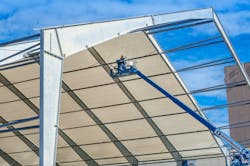Maintenance is an unpopular word. From car buyers and homeowners, to equipment operators and facility managers, the need to maintain a capital investment is universally recognized, yet mostly despised because of the time and expense involved. Simply put, when maintenance can be avoided, people tend to avoid it.
Airport officials are certainly no strangers to maintenance. Airplanes, conveyors, ground support equipment, and countless areas inside the terminals all need to be frequently maintained. Maintenance is everywhere at the airport. Well, almost everywhere.
For support buildings like aircraft hangars and cargo handling warehouses, a common industry solution is to utilize tension fabric structures. Fabric buildings have typically been chosen because of their quicker installation schedules and overall cost-effectiveness. Thanks to better engineering and improved materials, many of today’s fabric structures are practically maintenance-free as well, to the point where there’s almost zero upkeep actually needed for a quality fabric building.
A Real Steel
The biggest advancement for modern fabric buildings came several years ago when Legacy Building Solutions took the step of marrying together a tension fabric membrane with a structural steel I-beam frame, essentially bringing a conventional construction look to the fabric building industry.
Historically, fabric structures used a tubular web truss frame, characterized by a “hoop” shape with curved sidewalls. The appearance of a hoop structure wasn’t the issue. The main problem arose from the inconsistent engineering of truss designs. Different engineers often came to different subjective conclusions about the integrity of a given web truss framing system. A building collapsing due to an unidentified failure point was a real possibility.
By shifting toward rigid-frame, tapered I-beam design that was known and proven in the engineering community, newer fabric buildings removed any lingering question marks about the strength and longevity of the frame. This also opened up many possibilities for fabric building users, who could now have their structures customized to exact dimensions and other parameters, thanks to the design flexibility that is inherent with a rigid-frame approach.
Preventive Corrosion Protection
Beyond shear strength, structural steel I-beams have the advantage of being completely solid steel and, therefore, better suited to surviving high-humidity environments or just the basic long-term effects of corrosive elements over a building’s life cycle. By contrast, many tension fabric structures in the industry use hollow-tube frames that are vulnerable to corrosion originating inside the tube. In effect, truss frames can experience corrosive damage long before anyone can see it.
Although fabric liners are available to provide a finished building interior in certain applications, for aviation and many other industries, the steel beams are usually left exposed inside a fabric building. A variety of treatment options are available as a preventive maintenance measure against corrosion for the frame and other steel components.
Hot dip galvanizing has been among the most popular techniques. There is, however, a significant difference between galvanizing protection for solid beams and hollow tube frames. Tube frames are inline galvanized, meaning they’ve already been galvanized at the factory. The building supplier then welds the frames later, which diminishes the value of the galvanization where new heat is applied. With rigid I-beams, galvanizing occurs post-production, so the beams are already welded together before receiving topical treatments.
The same holds true for a recently introduced corrosion barrier offering for rigid frames – epoxy paint. Epoxy coating creates an actual barrier between corrosion and the steel beam, where galvanizing only slows down the corrosion process by sacrificing itself, allowing a thin zinc coating to be eaten away over time. Epoxy paint is quickly becoming recognized as a worthwhile investment to help extend the life cycle of buildings and equipment.
Fabric Longevity
One area where corrosion is definitely not a factor is with the fabric cladding material itself. Whether using polyvinyl chloride (PVC) or polyethylene (PE), architectural fabrics are not susceptible to corroding.
Tension fabric has long been known to provide a variety of operational benefits. Its translucency allows for natural daylighting inside a building. Unlike metal sheeting, fabric has thermally non-conductive properties, helping to keep building interiors warmer in the winter and cooler in the summer. However, like any single-layer material, if it’s necessary to eliminate condensation or provide heating or cooling, insulation and a fabric liner are definitely needed to provide superior results and meet energy code requirements.
Fabric’s benefits can be enjoyed for many years, but the type of fabric used can have a big impact on the roof’s overall longevity. PE fabric is the most widely used material in the industry, while PVC has been commonly reserved for higher end projects due to its price point. However, owners have realized that PVC’s long-term benefits and increased lifespan effectively offset the initial investment.
Legacy offers ExxoTec PVC, which features a high-strength woven fabric with additional primer and lacquer layers to provide more durability, and an improved warranty to match. This fabric is designed to retain more than double the tensile strength of a standard PE fabric and carries a longer life expectancy. These benefits have actually challenged building suppliers to think differently about the uses of the material and expanded the possibilities of fabric building design.
Fabric Performance
The natural properties of fabric and the way it’s manufactured help to deliver additional performance advantages that reduce building maintenance. Fabric provides a surface area that is leak-proof, ensuring superior protection of the interior environment. Users can consider washing down the interior side of the fabric if they want, but otherwise the occasional rainfall will take care of basic exterior cleaning.
Just like different fabrics can offer differing life expectancies, the method of installing and tensioning fabric can contribute to different long-term outcomes and maintenance needs. Older style hoop buildings often had mono-cover designs that involved stretching one piece of fabric over the entire structure. This design makes it difficult to properly tension the fabric and leaves it susceptible to additional movement from wind and snow. This will lead to premature wear, as well as potentially point-loading the structure in ways that it was not designed to resist.
Years ago, Legacy developed a fabric attachment system that uses half-inch bolts to secure a keder rail to the top flange of each structural steel frame instead of the industry-standard tek screw method. This method ensures fabric is properly attached and less likely to fail from improper screw installation.
The biggest advantage of the system was that it allowed for individual fabric panels – typically 20-feet wide – to be properly tensioned. Each and every section of the roof is horizontally and vertically tensioned in the correct order, which eliminates billowing of the fabric and ensures it remains taut throughout its lifespan.
In the event of an accident like a vehicle or aircraft being driven into a sidewall, or a violent storm causing flying debris to tear the fabric, users can focus their repair efforts on the affected fabric panels only. Likewise, when evaluating a building’s condition after a few decades of use, the possibility of only replacing certain individual panels holds true. With a mono-cover design, fabric replacement is an all-or-nothing proposition.
Airport Environment
Rigid frame tension fabric buildings are ideally suited to reduce maintenance concerns at airports in other ways as well. Their conventional architecture includes standard 18-inch overhangs, along with gutters and downspouts to assist with water mitigation. By contrast, buildings with curved sidewalls have no ability to control rain runoff; water simply runs down the side of the building, potentially causing damage to the foundations or even pooling and seeping inside the structure at the base.
Movement of air reduces any maintenance problems from humidity or moisture. Passive ventilation systems, using ridge and soffit vents, rely on the simple movement of warm air; and this passive ventilation is a standard feature for some rigid-frame building manufacturers. Additional mechanical ventilation can easily be added to the building frames if necessary.
Another benefit from a rigid-frame structure is the ability to handle hanging or live loads. From overhead cranes to fire suppression systems to conveyors, loads can be easily incorporated into the design from the beginning of the project. The I-beams are simply modified in the early engineering stages to account for the intended collateral or point loads.
The steel frame and attached fabric can also be designed to handle the environmental factors in a given location, such as wind loads, snow loads and seismic codes. This is particularly important for airports, which tend to be located in wide open areas with higher exposure to the wind and other elements.
Leading fabric building manufacturers have achieved a number of applicable certifications related to weather, such as Florida Product Approval for high-velocity hurricane zones. The derecho storm that whipped across Iowa and Illinois in August 2020 unleashed winds gusting up to 100 mph over an area 250 miles long. Users of two Legacy rigid-frame buildings in the storm’s path reported that their structures sustained no damage.
Trusted Construction
More good news for airports is that fabric buildings can also be engineered, manufactured and installed faster in the first place. Furthermore, while engineered to be permanent, most fabric structures are also designed to be portable if the need arises to move the building later.
In some cases, the whole project can be contracted through a single entity. Certain companies in the industry have their own manufacturing facilities on-site to produce everything from fabric panels to I-beams and components. They employ the engineers who work with the customer to design the building from the very beginning. Additionally, they employ their own in-house professional installation crews, ensuring the final construction job is done by those with the proper expertise. By acting as a one-stop full-service shop, these suppliers are able to guarantee quality and workmanship at every step of the process.
Ultimately, solid framing materials and better fabric technology wind up contributing to the equivalent of a robust long-term preventive maintenance program. With proven engineering leading the way, airports can procure fabric buildings that eliminate traditional headaches and maintenance, allowing users to focus on the primary aspects of their business.
Sara Davis has over 15 years of experience in sales and customer relations. She acts as a liaison between the customer and Legacy Building Solutions, helping aviation clients with their building solutions and bringing all parties to the table to streamline and enhance the purchasing process.
About the Author

